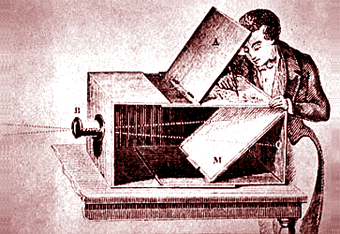In spite of the fact that Nicéphore Niépce - 1765-1833-is viewed as the dad of photography, it ought to be noticed that, as this development is the consequence of numerous endeavors in the field of physical science and science tried simultaneously in various nations, additionally Fox Talbot and Hippolyte Bayard has the right to share that schooling.
Lithography, created in Germany by Aloysius Senefelder in 1796, which comprises of drawing on a unique stone with a kind of oily paint that is washed in weakened corrosive and fixes the drawing, permitting to get a lot of proof on paper.
In his first trials, Nicéphore Niépce masterminded, at the lower part of a dim chamber, pieces of paper emulsified with silver salts, which darken under the activity of light. Niépce at that point acquired, in May 1816, the principal proliferation of a picture of nature, a photograph taken from his window. It was a negative, yet the picture won't be fixed, on the grounds that with a lot light, the paper winds up obscuring totally. He calls these pictures "retines".
In 1823, Niépce explored different avenues regarding lithography and therefore supplanted it with another strategy more appropriate for supporting the photographic picture: heliography.
In 1826, he took the first and most established known photo. It is obvious that the nature of the picture, gathered from the top of Niépce's home, isn't acceptable, however its recorded worth is undeniable, as it is the first that shows up to us, taken in 1826. It is realized that a couple of years prior, the researcher made at any rate three different endeavors, albeit the outcomes stayed extraordinary. To get his celebrated photo, a sheet made of a compound of tin, zinc and lead, known as tin, was utilized. The leaf was covered with an answer of lavender oil and bitumen from Judea. This combination would have the property of securing adequate hardness in contact with light. The creator named his photographic strategy for heliography.
Nicéphore Niépce's advantage in printing pictures has an extremely inquisitive root. This French designer and creator, extremely intrigued predominantly in getting specific kinds of transport motors, was a horrendous artist and his work required a technique that would permit him to catch reality as it was and, obviously, in light of the fact that he didn't confide in his own quality, he I needed to track down the correct framework.
In the same way as other people who attempted before him, the issue for Niépce was that he couldn't acquire the forever certain pictures, until he attempted the bitumen from Judea. His first displays endured five days and it required some investment to drop them off at the eight-hour Window View at Le Gras.
In 1829, Joseph Niépce joined Louis Daguerre, and they emulsified glass plates, creating them with oil fumes, acquiring better outcomes, more limited openness times, tones and nitty gritty shadows.








No comments:
Post a Comment